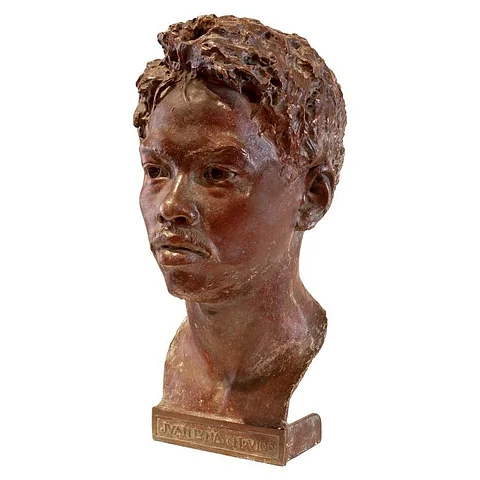
- NEWS
- the EDIT
- COMMENTARY
- BUSINESS
- LIFE
- SHOW
- ACTION
- GLOBAL GOALS
- SNAPS
- DYARYO TIRADA
- MORE

A fascinating tale forms the backdrop of the "Bust of Juan Luna y Novicio," withdrawn from a public auction yesterday that may be a prelude to a possibly long process to establish a claim.
The National Museum of the Philippines, or NMP, as custodian of the country's heritage works, is considering the recovery of the Filipino treasure.
Salcedo Auctions announced on Saturday the withdrawal of the sculpture from "The Well-Appointed Life" sale.
It said the bust's owner agreed to withhold the bust from the bidding as a gesture of "goodwill."
A spokesperson, however, lamented that the NMP had never filed a claim on the bust despite its existence being public knowledge for a long time. An in-depth article in a broadsheet was even written about it.
Only after the auctioneer was able to authenticate the piece of art did the NMP stake its claim to it, according to the auction house.
The Fundación Mariano Benlliure assisted Salcedo Auctions in authenticating the Luna bust. The artwork has a deep history.
Its creator, Mariano Benlliure y Gil, was a Spanish sculptor noted for his many public monuments celebrating notable Spanish figures, such as the ones of King Alfonso XII in Madrid and Queen Isabel la Católica in Granada.
Benlliure, a friend of the Filipino patriot, was known as the last master of 19th-century realism; careful executions of everyday events and persons characterized his sculptures.
In the pursuit of his dream to become a painter, Luna sailed for Europe in 1877.
A year later, he accompanied his mentor, Alejo Vera, to Rome as his assistant. There, Luna made the acquaintance and friendship of Benlliure and his brother, Juan Antonio, and Spanish pensionados who were in Rome at the time for their studies.
When Vera departed for home, Luna stayed behind and joined the Benlliures in an apartment on Via Marguita, where many other struggling artists lived. Theirs would be a lifelong and loyal friendship, with Luna painting a portrait of Lucrecia Arana, the sculptor's wife, one of the most famous zarzuela singers of the time.
Records show that a bronze bust of Juan Luna by Mariano, together with a copy of the Spoliarium painted by Juan Antonio, was commissioned by Don Vicente Palmori, Consul General of Spain.
Palmori was a personal friend of Luna's back in Rome in 1883, and it was written that these works were presented to the then-Philippine Governor General Leonard Wood on 21 October 1922 at the Marble Hall of the Ayuntamiento Building in Intramuros.
Wood created a Committee on Arrangements through Executive Order 54 of 1922 for the ceremony of delivery of these artworks.
The committee was headed by Don Fernando Zóbel, with the Spanish consul general heading the Committee on Presentations and the Governor General serving as chairman, representing the Philippine colonial government.
Both works were later displayed at the Old Legislative Building on Padre Burgos but were lost during the battle for the liberation of Manila in 1945.
In the aftermath of the war, a "junk collector presumably retrieved the bust from the rubble" and sold it to a junk dealer for P5 — not so much for its historical value but probably for its bronze content.
The junk dealer then offered it to Elsie "Inday" Cadapan, an influential social realist Filipino artist who used to run an antique store at the Mabini Arts Center in the 1970s.
It was Cadapan who, in 1979, sold the bust to East Asia Corporation for Arts & Antiquities, an affiliate of Multinational Investment Bancorporation, that was engaged in art dealership and brokerage that later merged with the institution via its managing director Amado Lacuesta.
